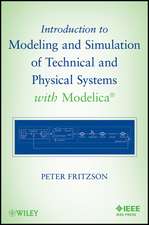Nonlinear Dynamical Systems in Engineering: Some Approximate Approaches
Autor Vasile Marinca, Nicolae Herisanuen Limba Engleză Paperback – 22 feb 2014
Every chapter introduces a distinct approximate method applicable to nonlinear dynamical systems. Each approximate analytical approach is accompanied by representative examples related to nonlinear dynamical systems from to various fields of engineering.
| Toate formatele și edițiile | Preț | Express |
|---|---|---|
| Paperback (1) | 949.73 lei 6-8 săpt. | |
| Springer Berlin, Heidelberg – 22 feb 2014 | 949.73 lei 6-8 săpt. | |
| Hardback (1) | 955.88 lei 6-8 săpt. | |
| Springer Berlin, Heidelberg – 5 ian 2012 | 955.88 lei 6-8 săpt. |
Preț: 949.73 lei
Preț vechi: 1158.20 lei
-18% Nou
Puncte Express: 1425
Preț estimativ în valută:
181.75€ • 197.36$ • 152.67£
181.75€ • 197.36$ • 152.67£
Carte tipărită la comandă
Livrare economică 22 aprilie-06 mai
Preluare comenzi: 021 569.72.76
Specificații
ISBN-13: 9783642434105
ISBN-10: 364243410X
Pagini: 408
Ilustrații: XII, 396 p.
Dimensiuni: 155 x 235 x 21 mm
Greutate: 0.57 kg
Ediția:2011
Editura: Springer Berlin, Heidelberg
Colecția Springer
Locul publicării:Berlin, Heidelberg, Germany
ISBN-10: 364243410X
Pagini: 408
Ilustrații: XII, 396 p.
Dimensiuni: 155 x 235 x 21 mm
Greutate: 0.57 kg
Ediția:2011
Editura: Springer Berlin, Heidelberg
Colecția Springer
Locul publicării:Berlin, Heidelberg, Germany
Public țintă
ResearchCuprins
Introduction.- Perturbation method (Lindstedt-Poincaré).- The method of harmonic balance.- The method of Krylov and Bogolyubov.- The method of multiple scales.- The optimal homotopy asymptotic method.- The optimal homotopy perturbation method.- The optimal variational iteration method.- Optimal parametric iteration method.
Textul de pe ultima copertă
This book presents and extends different known methods to solve different types of strong nonlinearities encountered by engineering systems. A better knowledge of the classical methods presented in the first part lead to a better choice of the so-called “base functions”. These are absolutely necessary to obtain the auxiliary functions involved in the optimal approaches which are presented in the second part.
Every chapter introduces a distinct approximate method applicable to nonlinear dynamical systems. Each approximate analytical approach is accompanied by representative examples related to nonlinear dynamical systems from various fields of engineering.
Every chapter introduces a distinct approximate method applicable to nonlinear dynamical systems. Each approximate analytical approach is accompanied by representative examples related to nonlinear dynamical systems from various fields of engineering.
Caracteristici
Provides a better understanding of the base functions and the auxialiary functions for optimal approaches Inspires to appreciate the beauty as well as the usefulness of the optimal analytical techniques Includes many representative examples from to various fields of engineering Includes supplementary material: sn.pub/extras














